Caravaggio’s faces, images and sensations are those of today, having far more immediacy, cutting edge and brute realism than anything by Damien Hirst or recent Turner Prize winners. Caravaggio was obsessed with the violence of life and painted the violence of sensation as the sensation of violence. … ( Alex Russell )
Moving on to Luigi Lanzi’s Storia Pittorica della Italia, which is the great history of Italian art from around 1800, Caravaggio remains a name to be conjured with, but the reasons why he is not wholly to be admired could not be more clearly expressed. It is not so much his manner as his subject matter—and his biography—that are deplored. Thus, on the credit side he is “memorable in this age, because he returned painting from mannerism to truth” (“dalla maniera alla verità”). Moreover “it seems that his figures inhabit a prison illuminated by minimal light coming from above” and “nevertheless they delight through the grand effect resulting from the contrast of light and shade”. However “he predominantly represented brawls, murders, and nocturnal betrayals; to which arts he himself was no stranger, for they ruined his life and brought infamy to his history.”
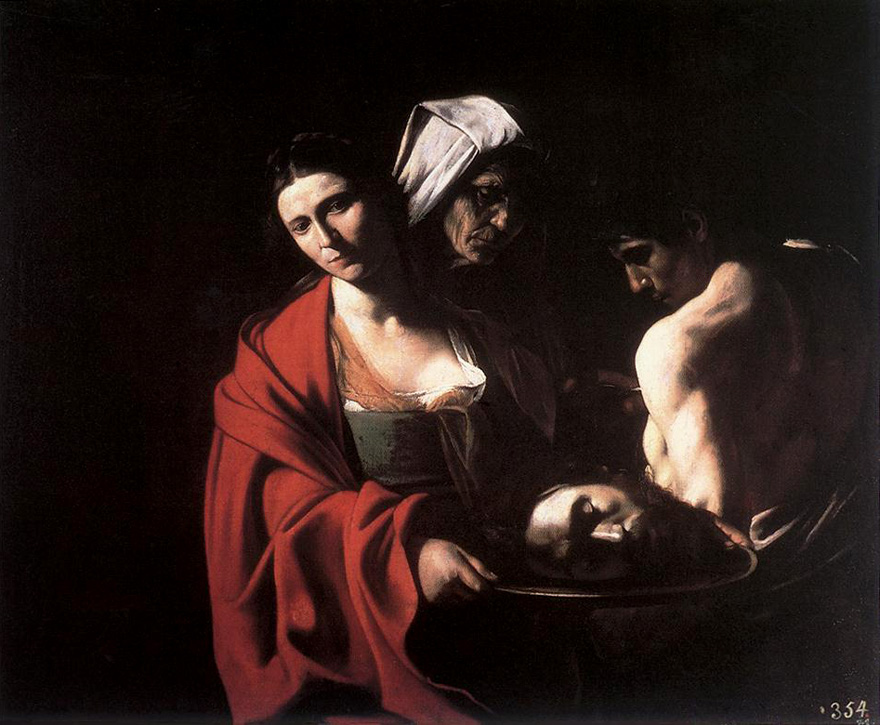
"Salome receives the Head of Saint John (1606-7) depicts another of Caravaggio’s self-portraits, this time as the severed head of St. John the Baptist. The sensuous severed head has a lingering and luminous iridescence as if lit from within, giving an auratic alteric glow of still being alive and not quite dead - too much for Salome to gaze upon, so she looks blankly at the viewer with an abject bored dullness. The three figures radiate their sublime alienation, absolutely cut off from one another severed by shadows. This is an enigmatic image: the severed head seems to have a life of its own."
Caravaggio( 1570-1609 ) is best remembered, and rightly so, for works testifying to the power of faith, and its terrible consequences. One can hardly doubt that Caravaggio himself experienced many of the ranges of emotion that inhabit his art. How else could he have painted with such passionate intensity. But he also gave equal attention to the secondary characters in his religious dramas; such as the poor people of the Trastevere section of Rome who became the mourners in “The Death of the Virgin”. He portrayed them all with unprecedented dignity, often offending some of his contemporaries with his egalitarian outlook.
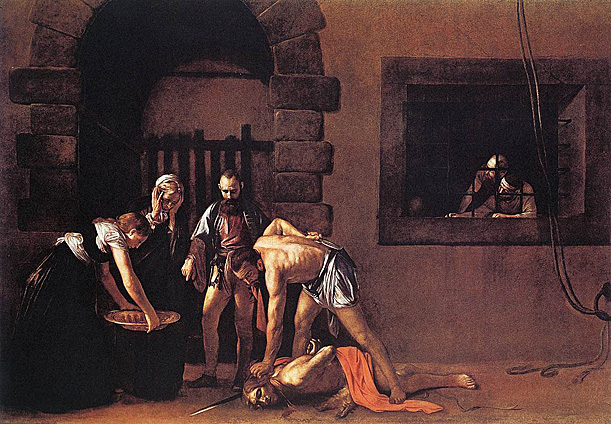
Caravaggio. The Beheading of Saint John the Baptist. "The Beheading of Saint John the Baptist is a painting finished in 1608 by the Italian Baroque painter Caravaggio. It is housed in the St. John's Co-Cathedral of La Valletta, Malta. The most important painting that Caravaggio made in Malta considered by many to be his greatest masterpiece. A magical balance of all the parts characterizes the piece. It is no accident that the artist brings into the painting precise reference to the setting, placing behind the figures as a backdrop the severe 16th century architecture of the prison building. At the window two figures silently witness the scene, and the commentators are thus drawn into the painting. They are not projected toward the outside as Caravaggio painted in the Martyrdom of St. Matthew. Figures well-known to him return (the old woman, the youth, the nude ruffian, the bearded nobleman), as do Lombard elements. The technical means adhere to the deliberate, programmatic limitation to which Caravaggio adapts them; but amid these soft tones, these dark colors, is an impressive sense of drawing that the artist does not give up, and that is visible even through the synoptic glints of light of his late works. This eminently classical balance, which projects the event beyond contingency, unleashes a harsh drama that is even more effective to the extent that, having given up the "aesthetic of exclamation" forever, Caravaggio limits every external, excessive sign of emotional emphasis. The painter signed in the Baptist's blood: "f (perhaps to understood as fecit rather than frater) michela...". This is the seal he placed on what may well be his greatest masterpiece."
The monks who commissioned “The Death of the Virgin” rejected it, and “Saint Matthew and the Angel” was Carravagio’s second attempt to paint an altarpiece for the Church of San Luigi dei Francesi, the first having been removed by priests on the grounds it was improper. During the Counter Reformation, art commissioned by the Church was meant to invite the contemplation of heaven and ignore the commonplace. Instead, with stubborn brilliance, Caravaggio interpreted spiritual events as if they were everyday experiences. In so doing he brought a disturbing realism to religious art. ….
An early published notice on him, dating from 1604 and describing his lifestyle three years previously, tells how “after a fortnight’s work he will swagger about for a month or two with a sword at his side and a servant following him, from one ball-court to the next, ever ready to engage in a fight or an argument, so that it is most awkward to get along with him.” In 1606 he killed a young man in a brawl and fled from Rome with a price on his head. In Malta in 1608 he was involved in another brawl, and yet another in Naples in 1609, possibly a deliberate attempt on his life by unidentified enemies. By the next year, after a relatively brief career, he was dead.
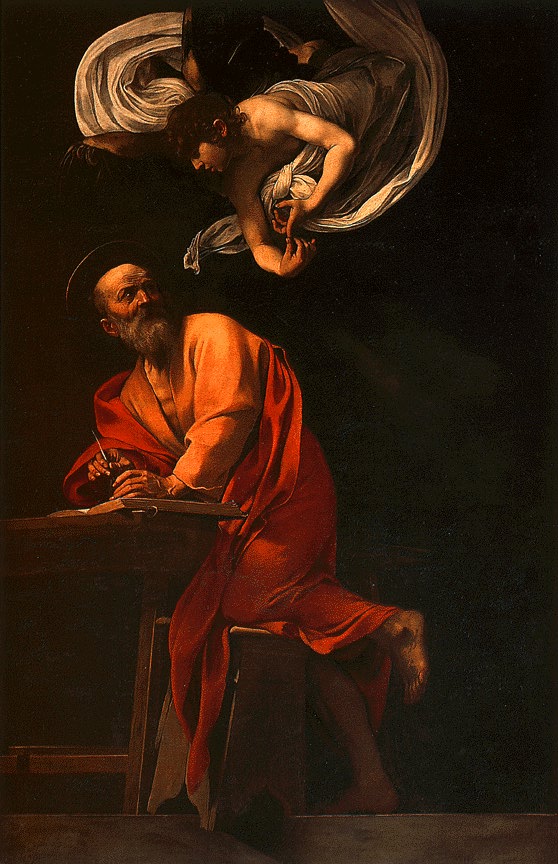
Saint matthew and the Angel. 1602. "The realism of the portrayal emphasises the harshness of the killing of the saint. The artist interprets with originality, the trend of the style of the Counter-reform, which insisted on the celebration of martyred saints. After having renounced the Sculptors' group of Jacob Cobaert {in the church of theTrinita dei PellegriniL the clergyman of San Luigi entrusted Caravaggio with the first version of the altar-piece with St. Matthew and the Angel, of doubtful date, wavering between 1593 and 1602. The work, quickly rejected because of the reduced size and for reasons of decorum, was acquired by the Marquis, Vincenzo Giustiniani (destroyed in Berlin during the last conflict) and substituted by the one which can now be seen on the altar, with the saint turned towards the angel and leaning with his legs on the stool precariously balanced on the steps."
It was always going to end badly. He ran with a rough crowd, did Michelangelo Merisi de Caravaggio. Roaming the cobbles under moonlight, a captive to his vices, the father of modern art was an incident waiting to happen. He promised rivals he would ‘fry their balls in oil’ and fought duels for the honour of prostitutes. He drew steel on a waiter over a disputed plate of artichokes. He wounded policemen. He killed a man in the street and had to go on the run. And finally, 401 years ago, this past July, he died penniless, desperate, feverish and alone. Yet somehow, during it all, he produced what may be the most arresting, influential and remarkable art in the history of the Christian West.
Whether all the incidents involving Caravaggio were in themselves comic or dangerous, or both, is beside the point; he was clearly embarked on a switchback ride of violence. In this, Caravaggio was probably no worse than thousands of other Roman rowdies; his talent however, made him substantially more conspicuous, and in the Spring of 1606 he finally made a mistake, stepped over the limit, and it would cost him his career.
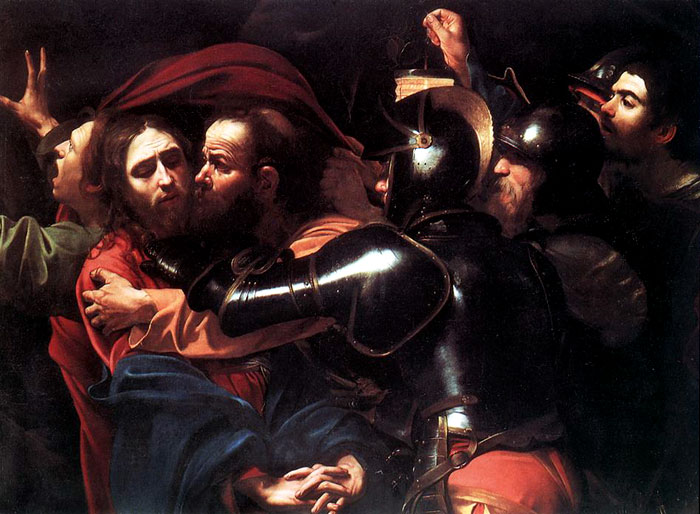
The Taking of Christ. "In this picture, he main figures of Jesus and Judas are pushed to the left, so that the right-hand half of the picture is left to the soldiers, whose suits of armor absorb what little light there is, and whose faces are the most part hidden. At the right of the picture, an unhelmeted head emerges from the surrounding darkness. This is often regarded as the artist's self-portrait. Caravaggio has also concerned himself here with the act of seeing as one of a painter's task. The three men on the right are there mainly to intensify the visual core of the painting, underscored by the lantern. On the left, the tactile aspect is not forgotten. Judas vigorously embraces his master, whilst a heavily mailed arm reaches above him towards Christ's throat. Christ, however, crosses his hands, which he holds out well in front of him, whilst St John flees shrieking into the deep night. His red cloak is torn from his shoulder. As it flaps open it binds the faces of Christ and Judas together&emdash;a deliberate touch on the artist's part. This painting was known only by copies until the original was discovered in a Jesuit rectory in Irela
It was brought to Boston College for its first American showing several years ago."Late in May, he was playing handball on the Campo Marzio, four to a side, There was a squabble over the score. Out came the daggers, and Caravaggio, himself stabbed in the brawl, killed one of his opponents, Rannucio Tomassoni, with a blow in the groin that presumably severed the femoral artery. He sought refuge south of Rome with a member of the Colonna family, knocked off a couple of paintings to raise some cash, and then fled to Naples. In the summer of 1607 he was on the move again, this time to Malta. There, for a little more than a year, he lived in security, enjoying the patronage of the Grand master of the Knights of Saint John, Alof de Wignacourt. Caravaggio painted a portrait of him, resplendent and smug in gold-inlaid ceremonial armor, and the gratified De Wignacort dubbed Caravaggio a Knight of Grace in 1608. That year in Makta the supreme painting of Caravaggio’s “late” period, for he was thirty-seven, and in some ways the capstone of his career, was completed; a canvas twelve by seventeen feet, of “The Beheading of Saint John The Baptist”.
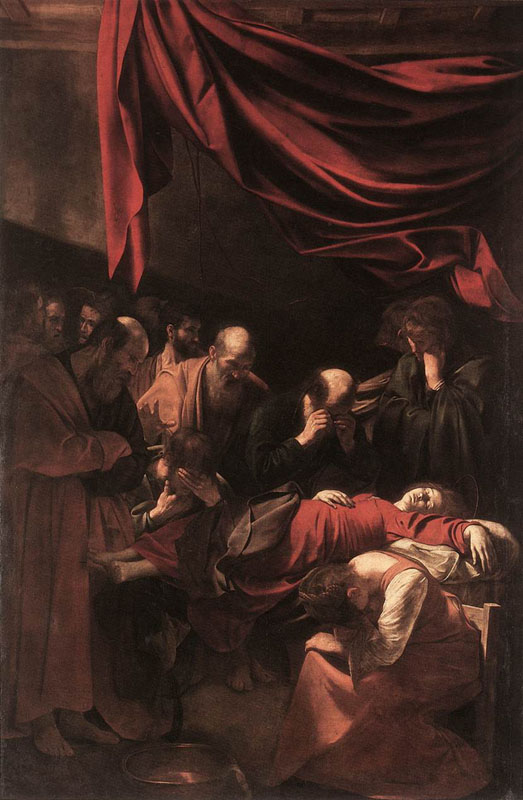
Death of the Virgin. " ...and the Death of the Virgin. The history of these last two paintings illustrate the reception given to some of Caravaggio's art, and the times in which he lived. The Grooms' Madonna, also known as Madonna dei palafrenieri, painted for a small altar in Saint Peter's Basilica in Rome, remained there for just two days, and was then taken off. A cardinal's secretary wrote: "In this painting there are but vulgarity, sacrilege, impiousness and disgust...One would say it is a work made by a painter that can paint well, but of a dark spirit, and who has been for a lot of time far from God, from His adoration, and from any good thought..." The Death of the Virgin, then, commissioned in 1601 by a wealthy jurist for his private chapel in the new Carmelite church of Santa Maria della Scala, was rejected by the Carmelites in 1606. Caravaggio's contemporary Giulio Mancini records that it was rejected because Caravaggio had used a well-known prostitute as his model for the Virgin; Giovanni Baglione, another contemporary, tells us it was due to Mary's bare legs —a matter of decorum in either case. Caravaggio scholar John Gash suggests that the problem for the Carmelites may have been theological rather than aesthetic, in that Caravaggio's version fails to assert the doctrine of the Assumption of Mary, the idea that the Mother of God did not die in any ordinary sense but was assumed into Heaven. The replacement altarpiece commissioned (from one of Caravaggio's most able followers, Carlo Saraceni), showed the Virgin not dead, as Caravaggio had painted her, but seated and dying; and even this was rejected, and replaced with a work which showed the Virgin not dying, but ascending into Heaven with choirs of angels. In any case, the rejection did not mean that Caravaggio or his paintings were out of favour. The Death of the Virgin was no sooner taken out of the church than it was purchased by the Duke of Mantua, on the advice of Rubens, and later acquired by Charles I of England before entering the French royal collection in 1671. "
By now, the jarring drama of Caravaggio’s earlier paintings had been purified; the screaming faces, the spurts of blood, the writhing muscles, and the flickering, irrational movements are sublimated in a meditation on death and guilt as grave and measured as any of the funerary masterpieces of neoclassicism: David’s “Death of Marat” or Canova’s “Tomb of the Countess Maria Christina”.
The Baptist is already dead, the action is over. The headsman is drawing the knife with which he will complete the decapitation. Salome bends forward with the plate; a prison warder, in Turkish dress, points to it; an old nurse, the wrinkled crone, again completing Caravaggio’s duality of beauty and its ruin, looks on in horror. Two prisoners stare from the window. The groups form immense and sombre structures, set- a thing uncommon in Caravaggio’s work- within a legible architectural space; the rusticated arch of the prison repeats the semi-circular curve of the group below it, and is in turn balanced by the yawning rectangle of the barred window.
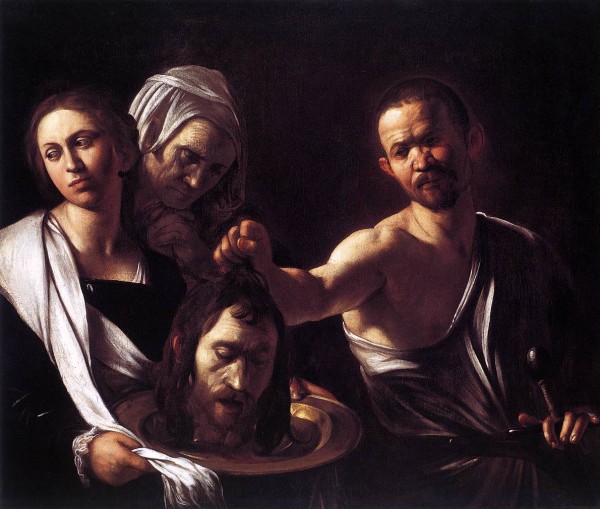
Salome With the head of Saint John. "The subject is from the New Testament (Mark 6). Salome had danced so well for King Herod that he swore he would grant her any request. Her mother, Herodias, who sought revenge on John the Baptist, persuaded Salome to ask for his head. The old woman behind Salome may be Herodias. This is a late work by the artist, painted in the last three years of his life, perhaps in Naples where he resided from 1609 to 1610. No longer concerned with the incidentals of the narrative, Caravaggio focuses on the essential human tragedy of the story."
“In this scene of martyrdom, shadow, which in earlier paintings stood thick about the figures, is here drawn back, and the infinite space that had been evoked by the huge empty areas of the earlier compositions is replaced by a high, overhanging wall. This high wall, which reappears in later works, can be linked to a consciousness in Caravaggio’s mind of condemnation to a limited space, the space between the narrow boundaries of flight and prison.”
“I have been studying how I may compare/ This prison where I live unto the world”. Shakespeare’s lines in Richard II are also, at this point, Caravaggio’s. Caravaggio’s signature is, in fact, traced in the dead saint’s blood. The baptist is almost any victim, killed professionally with no fanfare or cloud-borne angels, lying on the bare flagstones of a prison yard under the indifferent gaze of other prisoners who have seen it all before.
De Wignacourt rewarded Caravaggio for it with, among other things, a “rich collar of gold” and two slaves. But shortly afterward, by another of the grotesque ironies that beset his life, the painter was himself imprisoned; he had assaulted a Cavaliere di Giustizia. In October 1608, he managed to escape from his dungeon, climbed the fortress wall, and somehow escaped on a boat that was leaving Valetta. What followed was a nightmare. Furiously pursued by De Wignacourt’s hired thugs, Caravaggio reached Sicily and moved from city to city, getting commissions, painting them fast, and leaving on the run again. By November he had painted a large “Burial of Saint Lucy” in Syracuse; by December 6 he was in Messina, turning out “Raising of Lazarus”; in the summer of 1609 he was in Palermo and hard at work on a “Nativity”.
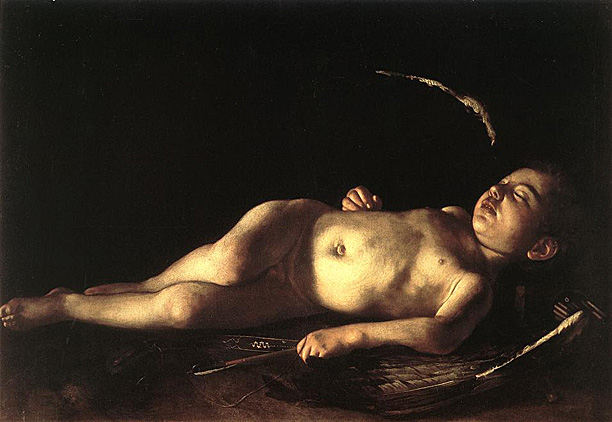
"Caravaggio’s Sated Cupid (1608) - with his bloated belly - looks truly sated – but with what? With wine, semen and sex? There is something desiccated, debauched, and dejected about this sexually gratified degenerate cherub. Sated Cupid is strikingly similar to Egon Schiele’s watercolour drawings of shrivelled, aged babies where senility is grafted on to a baby body. Caravaggio has stood the usual tradition on its head and instead of using a baby as a symbol of pretty innocence has chosen to show us a cherub which symbolises depravity, excess and decay: in its inversion it is intriguingly disturbing, even repellent, provoking a macabre and rather shameful sexual fascination. Is there something rather paedophilic in our sexual fascination by this louche and seedy old baby? Is it the molester or the molestee?"
It must have been a year of unspeakable fear for Caravaggio, and in almost ended in Naples in October, 1609, when De Wignacourt’s assassins caught up with him outside a thieves’ tavern. Somehow Caravaggio fought them off and, badly wounded, he started north.
The slow process of bureaucratic favor had been turning in Rome. Word reached him that he could expect a papal reprieve for the killing on the tennis court of Tomassoni. It remains unclear why Caravaggio did not go directly to Rome; possibly he decided to stay in territory not under Roman jurisdiction until he had firm news of the pardon; in any case he must have wanted to get as far as possible from De Wignacourt’s agents. The measure of his fear was that before quitting Naples,he packed a “Salome With the Head of Saint John” and sent it to Malta as a gift to the Grand Master. Then he boarded the felucca and set sail for Porto Ercole: for the shivering ague, the white beach, and the last interminable darkness. Three days after he died there, his pardon arrived.
“In the end …, paradoxically the real reason we revere Caravaggio is because we agree with so many previous commentators down the centuries about his art, but love what they loathed. It is the collision of unfiltered naturalism with an operatic sense of drama that makes Caravaggio so overwhelming, and it may not be by chance that his public breakthrough came in the age of film noir, when highly wrought chiaroscuro was the dominant cinematic—and therefore visual—mode. Now more than ever, our jaded sensibilities require extreme stimuli, and we are exceptionally impatient. The immediacy and directness of Caravaggio, allied to the death-fixated violence of so many of his creations, seem ideally suited to the present age. …”





 COMMENTS
COMMENTS